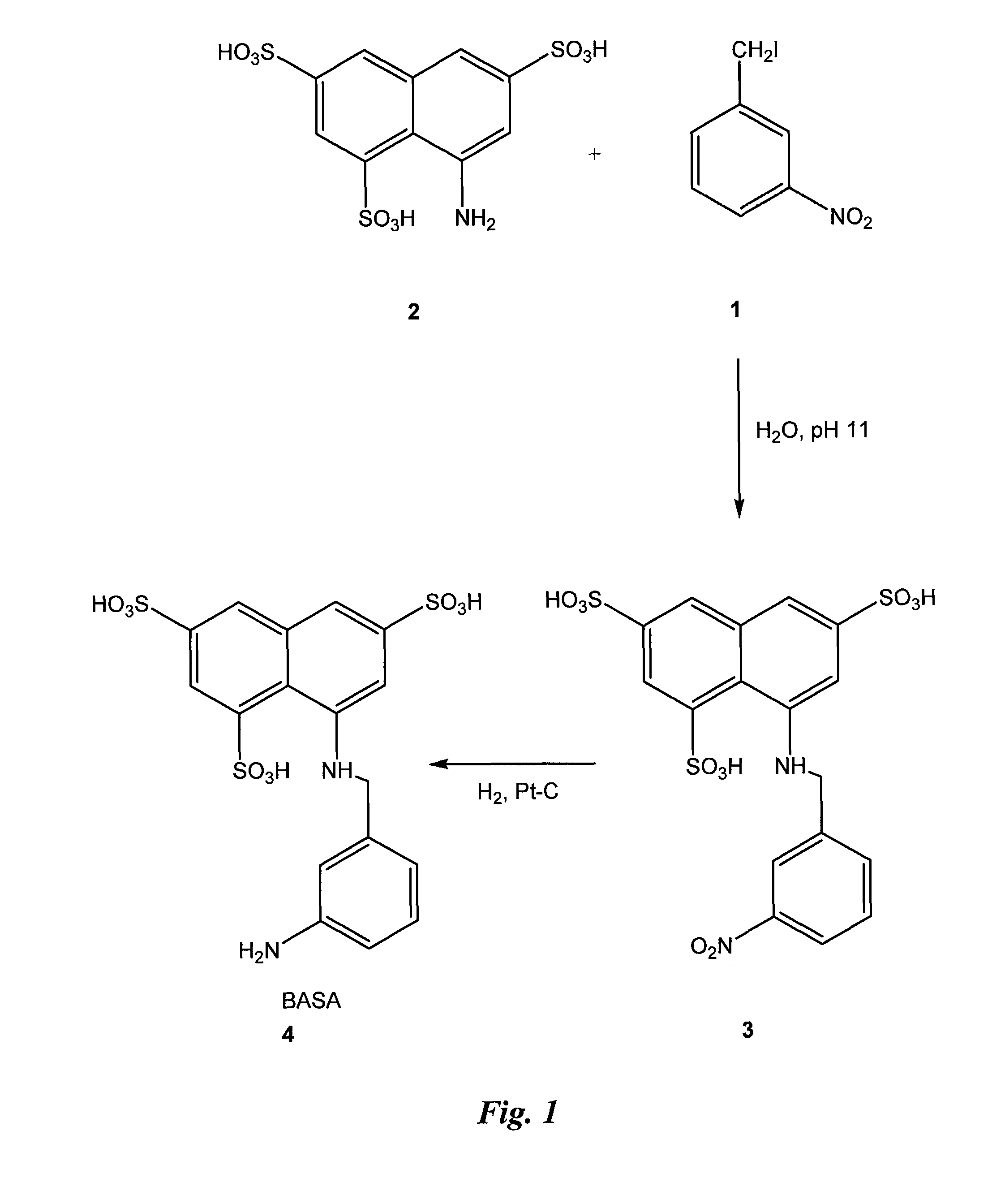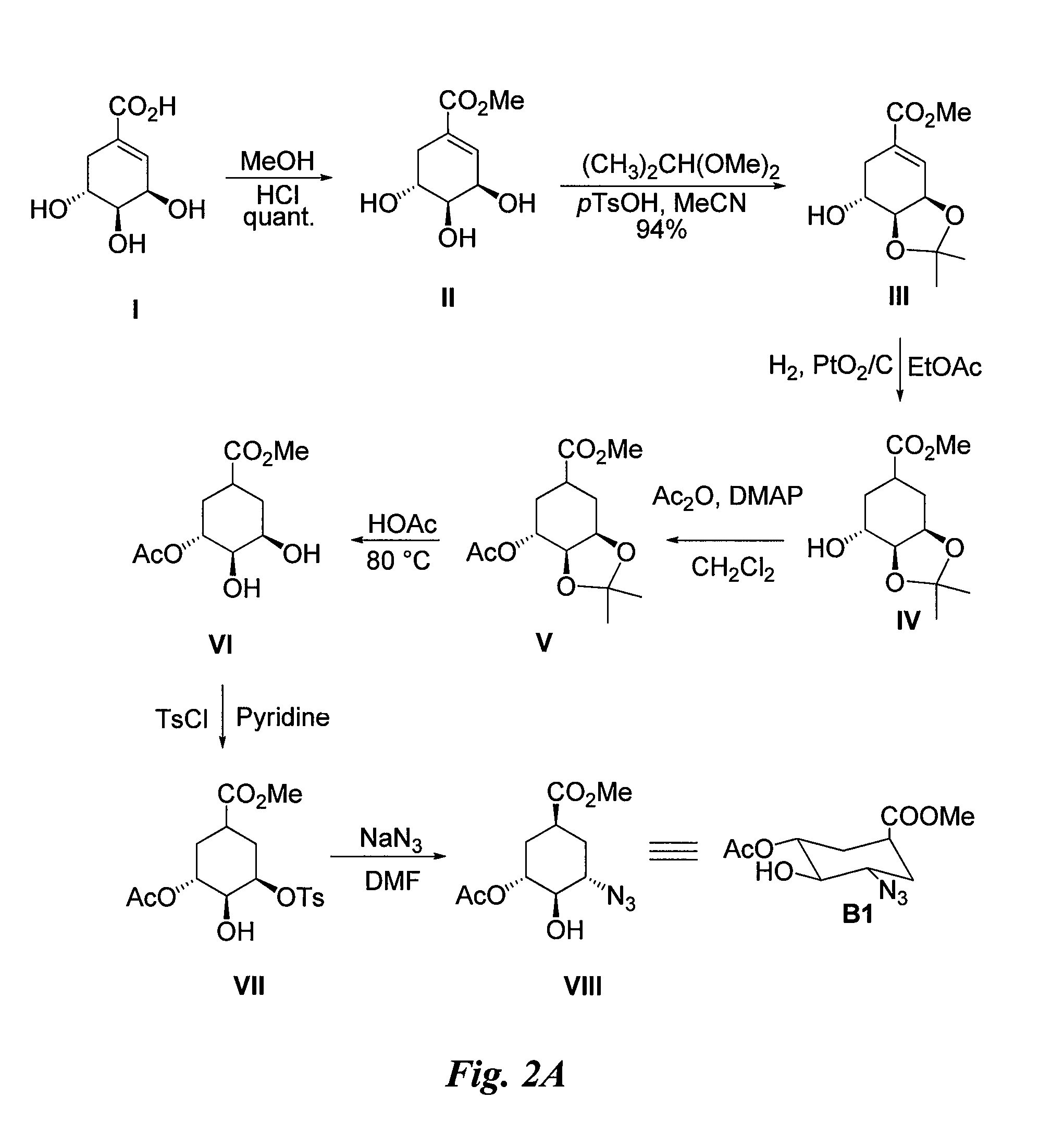Treatment of cancers of the blood using selected glycomimetic compounds
a technology of glycomimetic compounds and cancers, applied in the field of glycomimetics, can solve the problems of myeloablative bone marrow toxicities, chemotherapy has a number of deleterious side effects, and interferes with the production of normal blood cells of the bone marrow, and achieves the effect of reducing the toxicity of myeloablative bone marrow
- Summary
- Abstract
- Description
- Claims
- Application Information
AI Technical Summary
Benefits of technology
Problems solved by technology
Method used
Image
Examples
example 1
Synthesis of BASA (FIG. 1)
[0060]Synthesis of compound 4: 3-nitro-benzyl iodide (1) (48.3 g) is added to an aqueous solution (pH 11) of commercially available, 8-aminonaphthalene-1,3,5-trisulfonic acid (2) (29.5 g) with stirring at room temperature (RT). The pH of the solution is adjusted to 1 and after evaporation of the solvent, the product 3 (6.4 g) is precipitated out from ethanol.
[0061]Platinum catalyzed hydrogenation of compound 3 affords compound 4 (the benzylamino sulfonic acid or “BASA” of FIG. 1) in 96% yield.
example 2
Synthesis of Glycomimetic (FIG. 2)
[0062]Synthesis of intermediate II: (−)-Shikimic acid (20 g) in MeOH (200 ml) and sulfuric acid (2 ml, 98%) are stirred at RT for 50 h. The reaction mixture is neutralized with 2N aqueous NaOH in the cold. After evaporation to dryness, the residue is purified by silica gel chromatography to afford II (19.2 g).
[0063]Synthesis of intermediate III: Methyl shikimate (II, 10 g), 2,2 dimethoxypropane (10 ml) and p-TsOH (0.8 g) are dissolved in acetonitrile (125 ml) and stirred at RT for 1 h. The reaction mixture is then neutralized with triethylamine (2 ml) and evaporated to dryness. The residue is chromatographed on silica gel to yield III (11 g).
[0064]Synthesis of intermediate IV: The shikimic acid derivative III (10 g) and PtO2 / C (10%, 250 mg) in MeOH (40 ml) are hydrogenated at RT under vigorous stirring. After 16 h the reaction mixture is filtered over celite and evaporated to dryness. The residue is chromatographed on silica gel to yield IV.
[0065]Sy...
example 3
Synthesis of PEGylated BASA (FIG. 3)
[0077]To a solution of 3,6-dioxaoctanedioic acid (PEG, 200 mg, available commercially) in DMF (1 ml) is added Hunig base (0.4 ml), and then HATU (0.35 g) is added after 5 min. The solution is stirred at RT for 10 min. and then a solution of the BASA of Example 2 (50 mg) in DMF (0.1 ml) is added. The reaction mixture is stirred for 4 h at RT and the solvent is evaporated off. The residue is purified by hplc (reverse-phase C18 column) to give XX (40 mg).
PUM
| Property | Measurement | Unit |
|---|---|---|
| white | aaaaa | aaaaa |
| pharmaceutical composition | aaaaa | aaaaa |
| adhesion | aaaaa | aaaaa |
Abstract
Description
Claims
Application Information
 Login to View More
Login to View More - R&D
- Intellectual Property
- Life Sciences
- Materials
- Tech Scout
- Unparalleled Data Quality
- Higher Quality Content
- 60% Fewer Hallucinations
Browse by: Latest US Patents, China's latest patents, Technical Efficacy Thesaurus, Application Domain, Technology Topic, Popular Technical Reports.
© 2025 PatSnap. All rights reserved.Legal|Privacy policy|Modern Slavery Act Transparency Statement|Sitemap|About US| Contact US: help@patsnap.com



